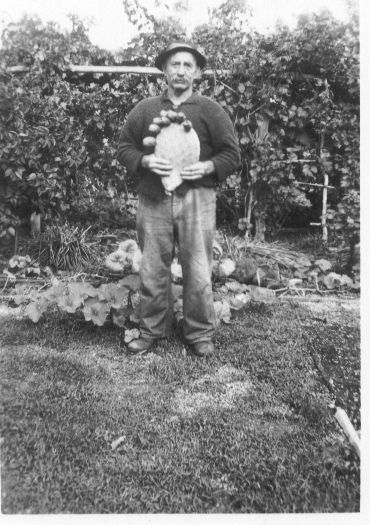Gardening in the Perth Hills
- Mundaring & Hills Historical Society

- Jul 7, 2025
- 3 min read
Updated: Jul 30, 2025
An article in the Echo about the 45th Anniversary of the Garden Club prompted us to look through our Collection for gardening related photographs.
The hills have always been known for beautiful gardens some have been opened to the public and in the early years we had two breeders of roses.
ROSARIANS
Rosarian Mr. Horace Mofflin lived at Blackwood in Darlington, a garden where he grew over 1000 roses and was the Foundation President of the National Rose Society of WA from 1932 to 1938. More information about him can be found on the Darlington History Group’s website.
Image 1 Horrace Mofflin and family 1932; Image 2 Horace Mofflin's Open Garden 1928; Image 3 Another view of Mofflin's Open Garden 1928; Image from Perth Region of Heritage Roses in Australia
Another rose breeder was Hugo Bommeli who in the 1930s was travelling by train to Wyalkatchem when he noticed a property in Parkerville which he later purchased and moved to from Bayswater to establish his second rose nursery. Bomeli was such a successful grower of roses that letters addressed to him from overseas would be addressed “The Rose King – Australia.” Hugo’s property was on Lots 610 and 700 Johnston Road Parkerville and straddled Jane Brook. The rootstock he used was “Fortuniana", most suitable for West Australian conditions.
Image 1 Hugo Bommeli working in the garden with his Rotatiller; Image 2 Bommeli family in 1956
MARKET GARDENS AND HOME PRODUCE
Early market gardening in Western Australia, particularly around Perth, was established shortly after the first European settlers arrived in 1829. By the early 1900s, market gardens, often operated by Chinese immigrants, were prevalent in areas like Leederville, utilising traditional techniques and facing significant social and legal challenges. By the early 20th century, Chinese immigrants, many from the Guangdong Province, dominated market gardening in Perth.
Chinese gardeners were known for their small-scale, intensive, and communal agricultural practices. They used traditional Chinese methods for digging wells and employed manual labour to cultivate crops, including intensive watering techniques. Chinese gardeners faced discrimination, including restrictions on land ownership, immigration policies, and bans on selling produce to certain markets.
In Ian Elliot’s book “Mundaring A History of the Shire” we are told at the time of early settlement in Darlington around 1900, the same time as vineyards were being established with Italian migrants, the Chinese immigrants were also establishing market gardens along the northern side of the railway - so approximately the southern end of Hillsden Road.
Image 1 Advert in the Daily News newspaper 9 December 1904 for Ah Ling and Co; Image 2 from WA Postal Directories 1904, showing 3 Chinese gardeners.
Image 1 Chinese market gardener, photograph credit Western Australian Museum; Image 2 Ian and Jan Lyon planting potatoes 1937; Mt Helena Stationmasters House 1935; Grace Hunter, a patient at Wooroloo Saitarium, sitting in front of the "men's garden" 1930
In the early 1900s agricultural enterprises were set up such as Charles Lauffer’s Helena River Nursery at the bottom of Hardey Road in Glen Forrest, and Jacob Hawter’s Fruit Tree Nursery on the slope between Glen Forrest and Darlington. The formerly terraced hillside can be seen on the north side when walking on the railway reserve trail.
Image 1 Charlese Lauffer's Helena River Nursery at the end of Hardey Road in Glen Forrest in 1903. You can still see the terraces Glen Hardey Vineyard next door; Image 2 View of Hawter's Nursery in 1900, which you can still see from the Railway Reserve Trail; Image 3 Another view of Hawter's Nursery.
As time went on all residents in the hills were creating their gardens for both ornamentals and for food! We have found some interesting photographs of vegetable growing in the hills. People have always grown their own food for their own family and sometimes to enter into competition as there is a history of horticultural shows taking place certainly in both Mundaring and Parkerville.
Image 1 Chidlow Primary School Headmaster, Oscar Mayrhofor, with a huge stick of rhubarb 1947; Peter Delabosca in his Chidlow garden in the 1940s; From WA Postal Directories 1904 showing names of Chinese gardeners in the Hills Area.


In the early 1900s agricultural enterprises were set up such as Charles Lauffer’s Helena River Nursery at the bottom of Hardey Road in Glen Forrest, and Jacob Hawter’s Fruit Tree Nursery on the slope between Glen Forrest and Darlington. The formerly terraced hillside can be seen on the north side when walking on the railway reserve trail.
The more we look the more we find in our collection here at MHHS. If you have any more information of early horticultural endeavours please contact us - details in the footer below.






































Comments